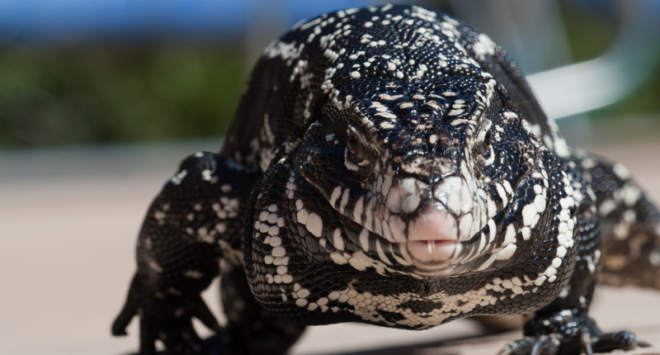Do you want your reptile pets to be warm, affectionate and attached to you? Do you also want your reptile pets to be unique? If yes, the Argentina-based Tegu Lizard is the best option for you. The Argentinian black and white tegu is also known as the giant tegu because it is the biggest among all tegu lizards.
Top 10 facts about the Tegu Lizard
Here are some interesting and must-know facts about these reptiles. These fats will help you understand them better and take good care of them.
1. Tegu Lizard Place of origin
The black and white tegu lizard is commonly found in the deserts and rainforests of South America and North America. These lizards are comfortable with swamps, meadows, and open fields as well, which make them quite popular across the globe today.
The Argentinian black and white tegu lizard belongs to the family of Telidae, and it hasthe scientific name of Salvatormeriane. This species of tegu lizard was originally discovered in 1839. Today, more than a century later, it continues to be a popular choice among lovers of reptile pets because of two important reasons – its huge size and intelligence quotient.
2. Are you buying the original tegu lizard
When you buy things for your house, a common and important policy that you would follow is to check their quality. You have to follow the same rule while buying tegu lizards from pet stores or dealers as well. Today, it is very common for pet-sellers to sell off the gold tegu or the Colombian black and white tegu (scientific name –Tupinambisteguixin) as the Argentinian black and white tegu.
You have to understand the differences between these 2 species if you have to be sure that you are buying the right variety of tegu lizard as your pet:
- Check for the eyes of the tegu lizard that you intend to buy and carefully observe the pupils. If they are round, you are holding the Argentinian breed in your hand, and if they are in the shape of a kidney, you are holding the Columbian breed.
- While the Salvatormeriane has a couple of loreal scales in the middle of its eye and nostrils, the Tupinambisteguixin has only one loreal scale in this region.
3. Tegu Lizard Physical appearance
When the Argentinian black and white tegu lizard is very young, it is in a bright emerald-green color. Yellow and black bands decorate the tails of the young tegu. However, as it grows, skin-shedding takes place, as a result of which the green skin turns into black. The bands around the tail too start losing their prominence. The tegu uses its tail as an attacking and defending weapon and can easily detach the tail, whenever it wants to.
The male tegu’s maximum height is of 4.5 feet, whereas the females can grow up to 3 feet long. The posterior teeth of the adult tegus are sharper, larger and more rounded than the ones found on the posterior side. Like most of the other reptiles, the skull of the tegu is very sturdy.
The mating process begins as soon as the hibernation phase is over. After a single mating session, the female lays close to 30 eggs, and they start hatching within 2 months.
4. Tegu lizard Food habits
The tegu lizards are omnivorous; therefore, they eat a healthy mix of insects, plants, fruits, poultry, meat and the like. Since they aren’t very fussy eaters, you can introduce dry dog foods, chicken, turkey, rodents, eggs, and insects to your tegu lizard pets in the initial days. Regardless of the food that you feed them, please remember to grind them nicely or break them into small parts, so that it doesn’t get stuck in the reptile’s throats.
Foods that are rich in proteins are good choices for tegu lizards. You can introduce fruits such as bananas, grapes, papaya, melons, mango, etc. in small quantities initially to check how your pet is responding to the same. You can increase the quantity of fruits gradually.
5. Caring for the tegu lizard
Before bringing a tegu lizard home, you have to get your setup right, to be able to provide a safe and comfortable environment for the pet. Since these are giant lizards, you will need an enclosure that is at least 6 feet long and 2 feet high. If you are planning to keep more than one tegu lizard in the enclosure, you have to opt for a bigger size than this, to give freedom for the pets to move about.
6. Tegu Lizard Heat and light settings
The heat and light settings of the enclosure and the quality of water that you feed the pets are two important reasons that will ensure the pets’ good health. The temperature inside the enclosure should be around 90 degrees F during the day and about 70 degrees F during the night time. Tegu lizards love to burrow inside the enclosures, but this shouldn’t stop you from fitting a good UV light inside.
7. Tegu Lizard Visual appeal of the enclosure
When you are setting up the enclosure, you should not only aim to make it visually appealing but also comfortable for the tegu lizards. They love to burrow often inside the enclosure; therefore, choosing natural substrates such as coconut husks and orchid barks help to mimic the natural habitats of these lizards.
Also, these lizards are known to move the plants and substrate within the enclosure quite frequently. Hence, it is highly recommended that you avoid toxic and dangerous substances such as hard rocks and ornamental plants inside the enclosure, while setting it up for your pets.
8. Tegu Lizard Price
The price of the tegu lizards is different in different geographies. Since there are many sources from where you can purchase them, the prices vary from one source to another. However, it is worth noting that you might have to shell out anywhere close to $200 to get your hands on a juvenile tegu lizard.
9. Tegu Lizard Lifespan
When you decide to get home a tegu lizard as a pet, you should be mentally prepared for a long-term relationship with the pet. The average lifespan of this reptile is around 15 years, but it can also live longer than that, if it is properly cared for.
10. Tegu lizard is an Intelligent pets
Tegu lizards are considered to be very intelligent, because they form an instant relationship with their owners. They are very warm and demand your full attention, when you get them home. They can recognize your voice and touch very quickly, but never get tempted to feed the lizard from your hand. This is to prevent yourself from accidental and painful bites.
Conclusion:
In conclusion, the Tegu lizard is a fascinating reptile with many unique characteristics that set it apart from other species. From their impressive size and intelligence to their ability to communicate and even recognize their owners, these creatures have captured the hearts of many reptile enthusiasts. While they can make excellent pets, it’s important to research and understand their care requirements before deciding to bring one into your home.
Frequently Asked Questions:
Are tegu lizards poisonous?
No, tegu lizards are not poisonous. They are non-venomous reptiles that rely on their strength and size for defense. While they can give a painful bite if they feel threatened or agitated, they are not venomous and their bites are not poisonous.
How much is a tegu lizard?
The cost of a tegu lizard can vary depending on factors such as age, size, and color morph. On average, tegu lizards can range in price from $100 to $500 or more.




